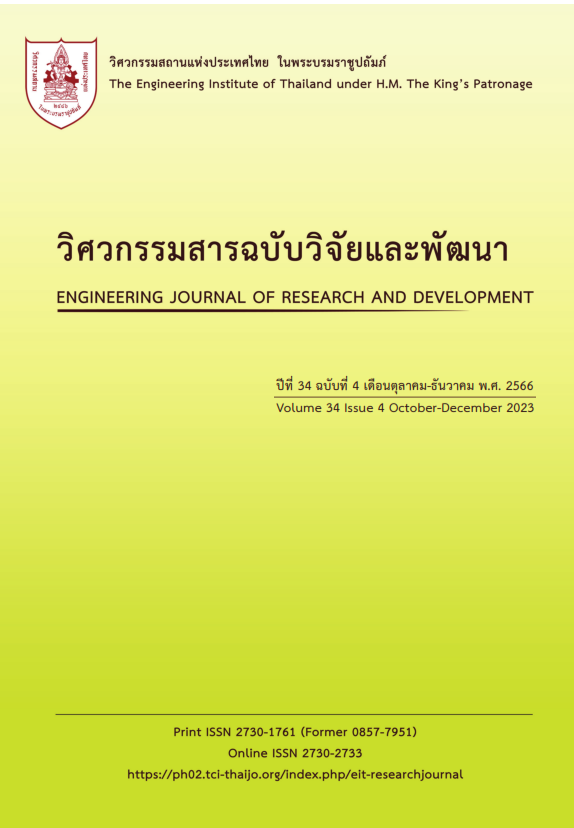DEVELOPMENT OF LIGHT-WEIGHT INTERLOCKING BLOCK CONTAINING RICE HUSK ASH
Main Article Content
Abstract
This research aimed to develop a light-weight interlocking block using rice husk ash, a waste material from rice husk burning in the production of rock salt. Twelve mixtures with the ratio between cement : dust stone : crushed rice husk ash : uncrushed rice husk ash equaled to 1:6:2:0 1:6:0:2 1:6:1:1 1:5:3:0 1:5:0:3 1:5:1.5:1.5 1:4:4:0 1:4:0:4 1:4:2:2 1:3:5:0 1:3:0:5 1:3 :1.5:1.5 by weight, were compressed into a lump with a dry density of about 1300 kg/m3. The compressive strength at the age of 7, 14 and 28 days and the water absorption at the age of 28 days were tested. The results indicated that when the amount of rice husk ash increased, the compressive strength and the water absorption increased. The compressive strength of the interlocking blocks at the age of 7, 14 and 28 days were in the range of 35 - 71, 43 - 81 and 53 - 109 kg/cm2, respectively. The water absorption at the age of 28 days were in the range of 446 - 546 kg/m3. All ratios of the interlocking blocks had the compressive strength through the standard of TCPS 602/2547, non-load-bearing type. The recommended ratio, which had the lowest cost, is 1:3:0:5.
Article Details

This work is licensed under a Creative Commons Attribution-NonCommercial-NoDerivatives 4.0 International License.
The published articles are copyright of the Engineering Journal of Research and Development, The Engineering Institute of Thailand Under H.M. The King's Patronage (EIT).
References
Saramakom, S. Usage of fly ash for manufacturing interlocking block. MSc thesis, Suranaree University of Technology, 2013.
Dechburum A. Interlocking block containing fly ash and bottom ash. MSc thesis, Mahasarakham University, 2018.
Paopongpaiboon, K. et al. Development of interlocking block blended with biomass ash for using as a insulating material. Engineering Journal of Research and Development, 2019, 30 (2), pp. 95-105.
Charoennatkul, C. Interlocking blocks containing oil palm ash and shells waste. Journal of Community Development and Life Quality, 2014, 2 (1), pp. 103-112.
Garaged, S. Interlocking block manufactured from cement and crushed golden apple snail shell. MSc thesis. Suranaree University of Technology, 2014.
Nuansawan, N. Utilization of label waste for making interlocking concrete paving block by using limestone power-cement as binder. MSc thesis. Chulalongkorn University, 2008.
Khamput, P. Development of Light-weight Interlocking block product from EVA plastic wastes. Thai Environmental Engineering Journal, 2016, 30 (3), pp 57-64.
Leeanansaksiri, A., Phochan, W. and Pongnum, T. Development of interlocking lightweight cement blocks from sludge ash mixed pozzolan material. Engineering Journal of Research and Development, 2020, 31 (1), pp. 135-143.
Thai Industrial Standard Institute. TCPS 602: 2547. Thai Community Product Standard of Interlocking Block. Bangkok: TISI, 2004.
Thai Industrial Standards Institute. TISI 109: 2517. Standard for Sampling and Testing Concrete Masonry Units. Bangkok: TISI, 1974.


